
National Register of Historic Places listings in Mobile, Alabama
Encyclopedia
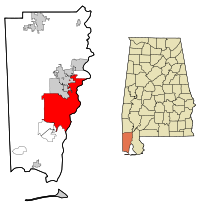
This is a list of the National Register of Historic Places listings in Mobile, Alabama.
This is intended to be a complete list of the properties and districts on the National Register of Historic Places
National Register of Historic Places
The National Register of Historic Places is the United States government's official list of districts, sites, buildings, structures, and objects deemed worthy of preservation...
in Mobile
Mobile, Alabama
Mobile is the third most populous city in the Southern US state of Alabama and is the county seat of Mobile County. It is located on the Mobile River and the central Gulf Coast of the United States. The population within the city limits was 195,111 during the 2010 census. It is the largest...
, Alabama
Alabama
Alabama is a state located in the southeastern region of the United States. It is bordered by Tennessee to the north, Georgia to the east, Florida and the Gulf of Mexico to the south, and Mississippi to the west. Alabama ranks 30th in total land area and ranks second in the size of its inland...
, United States
United States
The United States of America is a federal constitutional republic comprising fifty states and a federal district...
. Latitude and longitude coordinates are provided for many National Register properties and districts; these locations may be seen together in a Google map.
There are 126 properties and districts listed on the National Register in Mobile County
Mobile County, Alabama
Mobile County[p] is a county of the U.S. state of Alabama. Its name is in honor of a tribe of Indians, the Maubila tribe . As of 2011, its population was 415,704. Its county seat is Mobile, Alabama...
, including 4 National Historic Landmark
National Historic Landmark
A National Historic Landmark is a building, site, structure, object, or district, that is officially recognized by the United States government for its historical significance...
s. 104 of these sites, including all of the National Historic Landmarks, are located within the city limits of Mobile, and are listed here; the remaining 22 sites are listed separately.
History
Located at the junction of the Mobile RiverMobile River
The Mobile River is located in southern Alabama in the United States. Formed out of the confluence of the Tombigbee and Alabama rivers, the approximately river drains an area of of Alabama, with a watershed extending into Mississippi, Georgia, and Tennessee. Its drainage basin is the...
and Mobile Bay
Mobile Bay
Mobile Bay is an inlet of the Gulf of Mexico, lying within the state of Alabama in the United States. Its mouth is formed by the Fort Morgan Peninsula on the eastern side and Dauphin Island, a barrier island on the western side. The Mobile River and Tensaw River empty into the northern end of the...
on the northern Gulf of Mexico
Gulf of Mexico
The Gulf of Mexico is a partially landlocked ocean basin largely surrounded by the North American continent and the island of Cuba. It is bounded on the northeast, north and northwest by the Gulf Coast of the United States, on the southwest and south by Mexico, and on the southeast by Cuba. In...
, Mobile began as the first capital of colonial French Louisiana
Louisiana (New France)
Louisiana or French Louisiana was an administrative district of New France. Under French control from 1682–1763 and 1800–03, the area was named in honor of Louis XIV, by French explorer René-Robert Cavelier, Sieur de la Salle...
in 1702 and remained a part of New France
New France
New France was the area colonized by France in North America during a period beginning with the exploration of the Saint Lawrence River by Jacques Cartier in 1534 and ending with the cession of New France to Spain and Great Britain in 1763...
for over 60 years. The city was ceded to Great Britain
Great Britain
Great Britain or Britain is an island situated to the northwest of Continental Europe. It is the ninth largest island in the world, and the largest European island, as well as the largest of the British Isles...
in 1763, and under British rule the colony continued as part of West Florida
West Florida
West Florida was a region on the north shore of the Gulf of Mexico, which underwent several boundary and sovereignty changes during its history. West Florida was first established in 1763 by the British government; as its name suggests it largely consisted of the western portion of the region...
. Spain
Spain
Spain , officially the Kingdom of Spain languages]] under the European Charter for Regional or Minority Languages. In each of these, Spain's official name is as follows:;;;;;;), is a country and member state of the European Union located in southwestern Europe on the Iberian Peninsula...
captured Mobile during the American Revolutionary War
American Revolutionary War
The American Revolutionary War , the American War of Independence, or simply the Revolutionary War, began as a war between the Kingdom of Great Britain and thirteen British colonies in North America, and ended in a global war between several European great powers.The war was the result of the...
in 1780, with the Battle of Fort Charlotte
Battle of Fort Charlotte
The Battle of Fort Charlotte or the Siege of Fort Charlotte was a two-week siege conducted by Spanish General Bernardo de Gálvez against the British fortifications guarding the port of Mobile during the American Revolutionary War...
.
The city first became a part of the United States in 1813, following the U.S. seizure of Spanish West Florida during the War of 1812
War of 1812
The War of 1812 was a military conflict fought between the forces of the United States of America and those of the British Empire. The Americans declared war in 1812 for several reasons, including trade restrictions because of Britain's ongoing war with France, impressment of American merchant...
. The city and surrounding territory was first added to the Mississippi Territory
Mississippi Territory
The Territory of Mississippi was an organized incorporated territory of the United States that existed from April 7, 1798, until December 10, 1817, when the final extent of the territory was admitted to the Union as the state of Mississippi....
. It was included in the Alabama Territory
Alabama Territory
The Territory of Alabama was an organized incorporated territory of the United States that existed from August 15, 1817, until December 14, 1819, when it was admitted to the Union as the State of Alabama.-History:...
in 1817, after Mississippi
Mississippi
Mississippi is a U.S. state located in the Southern United States. Jackson is the state capital and largest city. The name of the state derives from the Mississippi River, which flows along its western boundary, whose name comes from the Ojibwe word misi-ziibi...
gained statehood. A fire in October 1827 destroyed most of the old colonial buildings in the city, but from the 1830s onward Mobile expanded with a primary focus on the cotton trade. The city experienced another major fire in 1839 that burned a large central portion of the city and destroyed many of its finest new buildings. On May 25, 1865 an ammunition depot explosion, termed the great Mobile magazine explosion
Mobile magazine explosion
On May 25, 1865, in Mobile, Alabama, in the Southern United States, an ordnance depot or "magazine" exploded, killing some 300 persons. This event occurred just after the end of the American Civil War, during the occupation of the city by victorious Federal troops....
, killed some 300 people and destroyed the northern portion of the city.
Mobile's population had increased from around 40,000 people in 1900 to 60,000 by 1920. Between 1940 and 1943, over 89,000 people moved into Mobile to work for war effort industries. By 1956 the city limits had tripled to accommodate growth. The city lost many of its historic buildings during urban renewal
Urban renewal
Urban renewal is a program of land redevelopment in areas of moderate to high density urban land use. Renewal has had both successes and failures. Its modern incarnation began in the late 19th century in developed nations and experienced an intense phase in the late 1940s – under the rubric of...
in the 1960s and 1970s. This led to the establishment of the Mobile Historic Development Commission, charged with protecting and enhancing the city's historic resources. Beginning in the late 1980s, the city began an effort termed the "String of Pearls Initiative" to make Mobile into a competitive, urban city. This effort would see numerous projects around the city, including the restoration of hundreds of historic buildings and homes.
Architecture
Mobile has antebellum architectural examples of the FederalFederal architecture
Federal-style architecture is the name for the classicizing architecture built in the United States between c. 1780 and 1830, and particularly from 1785 to 1815. This style shares its name with its era, the Federal Period. The name Federal style is also used in association with furniture design...
, Greek Revival, Gothic Revival, and Italianate styles. Additionally, the Creole cottage
Creole cottage
Creole cottage is a term loosely used to refer to a type of vernacular architecture indigenous to the Gulf Coast of the United States. Within this building type comes a series of variations. An expanded version of this type of building is commonly referred to as Gulf Coast cottage, with the...
and Gulf Coast cottage are building types that are indigenous to the area, and are among the earliest surviving house types. Mobile's downtown townhouses, primarily built between the 1840s and 1860s, typically combine Late Federal style architecture with Greek Revival or Italianate elements and cast iron
Cast iron
Cast iron is derived from pig iron, and while it usually refers to gray iron, it also identifies a large group of ferrous alloys which solidify with a eutectic. The color of a fractured surface can be used to identify an alloy. White cast iron is named after its white surface when fractured, due...
galleries.
Current listings
| Site name | Image | Date listed | Location | Summary | |
|---|---|---|---|---|---|
| 1 | Aimwell Baptist Church Aimwell Baptist Church (Mobile, Alabama) Aimwell Baptist Church is a historic African American church in Mobile, Alabama. The Baptist congregation was established in 1890 by two brothers, it took two years for the erection of the first building. The current building, with Gothic Revival influences, was designed in 1946 by Nathaniel... |
500 Earle St. 30°41′58"N 88°3′10"W |
The congregation of this historically African American Baptist Baptist Baptists comprise a group of Christian denominations and churches that subscribe to a doctrine that baptism should be performed only for professing believers , and that it must be done by immersion... church was established in 1890. The current church building dates to 1946. |
||
| 2 | Ashland Place Historic District Ashland Place Historic District (Mobile, Alabama) The Ashland Place Historic District is a historic district in the city of Mobile, Alabama, United States. The neighborhood gained its name from a Greek Revival antebellum house called Ashland that once stood on Lanier Avenue. Ashland was famous as the home of Augusta Evans Wilson. The house... |
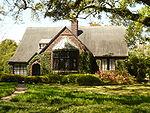 |
Roughly bounded by Springhill and Ryan Aves., Old Shell Rd., and Levert Ave. 30°41′26"N 88°5′40"W |
This historic district Historic district (United States) In the United States, a historic district is a group of buildings, properties, or sites that have been designated by one of several entities on different levels as historically or architecturally significant. Buildings, structures, objects and sites within a historic district are normally divided... is an early 20th century neighborhood consisting of over 90 homes. Architectural styles range from late Victorian to the Craftsman and Tudor Revival. |
|
| 3 | Wade Askew House Wade Askew House The Wade Askew House is a historic residence in Mobile, Alabama, United States. It was built in 1927 in the Spanish Colonial Revival style. The building was placed on the National Register of Historic Places on July 12, 1991. It is a part of the Spanish Revival Residences in Mobile Multiple... |
 |
103 Florence Pl. 30°41′17"N 88°5′22"W |
This bungalow in Midtown was built in 1927. It is one of the many Spanish Colonial Revival Spanish Colonial Revival Style architecture The Spanish Colonial Revival Style was a United States architectural stylistic movement that came about in the early 20th century, starting in California and Florida as a regional expression related to history, environment, and nostalgia... style houses in the Florence Place subdivision, established on what was the outskirts of Mobile in the 1920s. The subdivision was planned to have Spanish Revival houses only, reflecting the popularity of the style in the city during the early 20th century. |
|
| 4 | Azalea Court Apartments Azalea Court Apartments The Azalea Court Apartments is a historic three-story apartment building located in Mobile, Alabama. It was built in 1928 and was designed by architect J. Platt Roberts in the Spanish Colonial Revival style. It was added to the National Register of Historic Places on February 11, 1988.... |
 |
1820 Old Government St. 30°40′41"N 88°4′59"W |
This three-story Spanish Colonial Revival style apartment building in Midtown was built in 1928. | |
| 5 | Barton Academy Barton Academy Barton Academy is a historic Greek Revival school building located on Government Street in Mobile, Alabama, United States. It was under construction from 1836 to 1839 and was designed by architects James H. Dakin, Charles B. Dakin, and James Gallier. Gallier and the Dakin brothers also designed... |
 |
504 Government St. 30°41′21"N 88°2′57"W |
This Greek Revival Greek Revival architecture The Greek Revival was an architectural movement of the late 18th and early 19th centuries, predominantly in Northern Europe and the United States. A product of Hellenism, it may be looked upon as the last phase in the development of Neoclassical architecture... school building, designed by architects James Gallier James Gallier James Gallier was a prominent New Orleans architect.He was born James Gallagher in Ravensdale, County Louth, Ireland in 1798. He worked in England during his early career, designing the Godmanchester Chinese Bridge which crosses a mill stream of the River Great Ouse in 1827, and then working on the... , James H. Dakin James H. Dakin James Harrison Dakin , American architect, was the son of James and Lucy Harrison Dakin of Hudson, New York, and born in Northeast Township. He was seventh in line from the immigrant ancestor, Thomas Dakin, of Concord, Massachusetts, through Simon, of the third generation, who went to Putnam... and Charles B. Dakin, was completed in 1836. It was the first public school in the state of Alabama. |
|
| 6 | Battle House Royale | 26 N. Royal St. 30°41′35"N 88°2′28"W |
This downtown hotel was established in 1852. Guests have included Stephen A. Douglas Stephen A. Douglas Stephen Arnold Douglas was an American politician from the western state of Illinois, and was the Northern Democratic Party nominee for President in 1860. He lost to the Republican Party's candidate, Abraham Lincoln, whom he had defeated two years earlier in a Senate contest following a famed... , Henry Clay Henry Clay Henry Clay, Sr. , was a lawyer, politician and skilled orator who represented Kentucky separately in both the Senate and in the House of Representatives... , Jefferson Davis Jefferson Davis Jefferson Finis Davis , also known as Jeff Davis, was an American statesman and leader of the Confederacy during the American Civil War, serving as President for its entire history. He was born in Kentucky to Samuel and Jane Davis... , Millard Fillmore Millard Fillmore Millard Fillmore was the 13th President of the United States and the last member of the Whig Party to hold the office of president... , Winfield Scott Winfield Scott Winfield Scott was a United States Army general, and unsuccessful presidential candidate of the Whig Party in 1852.... , and Woodrow Wilson Woodrow Wilson Thomas Woodrow Wilson was the 28th President of the United States, from 1913 to 1921. A leader of the Progressive Movement, he served as President of Princeton University from 1902 to 1910, and then as the Governor of New Jersey from 1911 to 1913... . The first building burned in 1905. The current structure was completed in 1908 and is one of the earliest steel frame structures remaining in Alabama. |
||
| 7 | Beal-Gaillard House Beal-Gaillard House The Beal-Gaillard House is a historic residence in Mobile, Alabama. It was built in 1836 in a Creole cottage style. It was placed on the National Register of Historic Places on October 18, 1984 as a part of the 19th Century Spring Hill Neighborhood Thematic Resource.... |
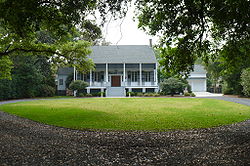 |
111 Myrtlewood Ln. 30°41′56"N 88°7′59"W |
This Creole cottage Creole cottage Creole cottage is a term loosely used to refer to a type of vernacular architecture indigenous to the Gulf Coast of the United States. Within this building type comes a series of variations. An expanded version of this type of building is commonly referred to as Gulf Coast cottage, with the... style house was built in 1836 in what was then the village of Spring Hill. Spring Hill was primarily settled by Mobilians attempting to escape the heat and disease that plagued the city during the warm summer months. |
|
| 8 | Bragg-Mitchell House Bragg-Mitchell Mansion The Bragg-Mitchell Mansion, also known as the Bragg-Mitchell House, is a historic house museum in Mobile, Alabama. It was built in 1855 by Judge John Bragg and is one of the most photographed buildings in the city as well as one of the more popular tourist attractions. The house has been... |
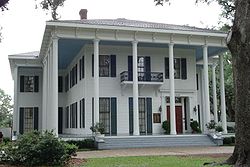 |
1906 Springhill Ave. 30°41′32"N 88°5′11"W |
This two-story mansion was built by John Bragg John Bragg (politician) John Bragg was a U.S. Representative from Alabama.Born near Warrenton, North Carolina, Bragg attended the local academy at Warrenton, and was graduated from the University of North Carolina at Chapel Hill in 1824.... in 1855. It uses Greek Revival and Italianate Italianate architecture The Italianate style of architecture was a distinct 19th-century phase in the history of Classical architecture. In the Italianate style, the models and architectural vocabulary of 16th-century Italian Renaissance architecture, which had served as inspiration for both Palladianism and... stylistic elements in a combination referred to as "bracketed Greek Revival". |
|
| 9 | Brisk & Jacobson Store Brisk & Jacobson Store The Brisk & Jacobson Store is a historic Italianate-style commercial building in Mobile, Alabama. It was placed on the National Register of Historic Places on March 14, 1973.-History:... |
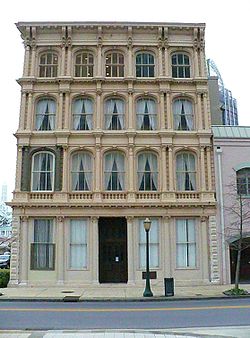 |
2 Dauphin St. 30°41′32"N 88°2′23"W |
This Italianate Italianate architecture The Italianate style of architecture was a distinct 19th-century phase in the history of Classical architecture. In the Italianate style, the models and architectural vocabulary of 16th-century Italian Renaissance architecture, which had served as inspiration for both Palladianism and... -style commercial building was completed in 1866 by local merchants Isaac Goldsmith and William Frohlichstein. The four-story structure features an early cast iron Cast iron Cast iron is derived from pig iron, and while it usually refers to gray iron, it also identifies a large group of ferrous alloys which solidify with a eutectic. The color of a fractured surface can be used to identify an alloy. White cast iron is named after its white surface when fractured, due... facade by Daniel D. Badger's Architectural Iron Works. |
|
| 10 | The Campground Campground Historic District The Campground Historic District is a historic district in the city of Mobile, Alabama, United States. Named for the Old Camp Ground, a military encampment that occupied the property during the American Civil War, this historically African American neighborhood was placed on the National Register... |
Martin Luther King Jr. Ave., Rylands St., St. Stephens Rd., and Ann St. 30°41′46"N 88°3′59"W |
This historic district encompasses a historically African American neighborhood consisting of over 166 contributing buildings. The houses date from the late 19th century to the middle 20th century. It is on the African American Heritage Trail of Mobile. | ||
| 11 | Carlen House Carlen House The Carlen House, also known as the Carlen House Museum, is a historic house museum in Mobile, Alabama, United States. The house was built in the Gulf Coast cottage style in 1843. It was the residence of Michael and Mary Carlen, Irish immigrants, and their twelve children... |
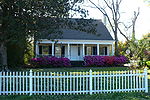 |
54 S. Carlen St. 30°41′2"N 88°5′11"W |
This Gulf Coast cottage Creole cottage Creole cottage is a term loosely used to refer to a type of vernacular architecture indigenous to the Gulf Coast of the United States. Within this building type comes a series of variations. An expanded version of this type of building is commonly referred to as Gulf Coast cottage, with the... style house in Midtown was built in 1843 by Irish Ireland Ireland is an island to the northwest of continental Europe. It is the third-largest island in Europe and the twentieth-largest island on Earth... immigrants to Mobile, Michael and Mary Carlen. |
|
| 12 | Carolina Hall Carolina Hall Carolina Hall is a historic residence in Mobile, Alabama, United States. It was built in 1832 in a Federal style and later altered to a Greek Revival style. It was placed on the National Register of Historic Places on January 18, 1973.... |
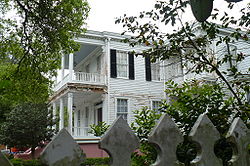 |
70 S. McGregor St. 30°41′29"N 88°8′37"W |
This mansion in the Spring Hill neighborhood began as a Federal Federal architecture Federal-style architecture is the name for the classicizing architecture built in the United States between c. 1780 and 1830, and particularly from 1785 to 1815. This style shares its name with its era, the Federal Period. The name Federal style is also used in association with furniture design... style house in 1832. It was later expanded and remodeled in the Greek Revival style. |
|
| 13 | Cavallero House Cavallero House The Cavallero House is a historic residence in Mobile, Alabama. It was built in 1835 in the Federal style, a cast iron gallery was added in the mid-19th century. The house was added to the National Register of Historic Places on October 07, 1982... |
 |
7 N. Jackson St. 30°41′27"N 88°2′42"W |
This two-and-a-half-story brick townhouse was built in 1835. Cast iron galleries were added to the front in the mid-19th century. | |
| 14 | Center-Gaillard House Center-Gaillard House The Center-Gaillard House is a historic residence in Mobile, Alabama. The earliest part of the house was built in 1827. It was placed on the National Register of Historic Places on October 18, 1984 as a part of the 19th Century Spring Hill Neighborhood Thematic Resource.-References:... |
3500 The Cedars 30°42′5"N 88°8′6"W |
This two-story house in the Spring Hill neighborhood began as a retreat in 1827 and was expanded several times in the 19th century. | ||
| 15 | Church Street East Historic District Church Street East Historic District The Church Street East Historic District is a historic district in the city of Mobile, Alabama, United States. It was placed on the National Register of Historic Places on 16 December 1971. Since a boundary increase on 13 January 1984, it is roughly bounded by Broad, Conti, Water, Claiborne, and... |
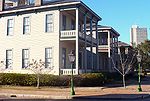 |
Roughly bounded by Conti, Water, Claiborne, Eslava, Warren, and Bayou Sts.; also roughly bounded by Broad, Conti, Water, Claiborne, and Canal Sts.; also 66 and 68 S. Royal St. 30°41′16"N 88°2′44"W |
This downtown historic district features government, museum, commercial, and residential structures in a variety of 19th century styles. It contains 83 contributing buildings and one object. The second and third sets of boundaries represent boundary increases of and respectively. | |
| 16 | U. J. Cleveland House U. J. Cleveland House The U. J. Cleveland House, also known as the Thomas Smith House is a historic residence in Mobile, Alabama, United States. The -story wood-frame structure, on brick piers, was built in 1853 in the Gulf Coast Cottage style. It was placed on the National Register of Historic Places on May 21,... |
551 Charles St. 30°40′35"N 88°3′24"W |
This Gulf Coast cottage style house was built in 1853. | ||
| 17 | Coley Building Coley Building The Coley Building was a historic two-story commercial building in Mobile, Alabama. It began as a one-story Federal style masonry structure in 1836. It was the last 19th century building to survive on its city block. The block, situated between the streets of St. Francis, Royal, Water, and St.... |
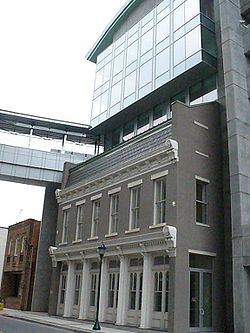 |
56 St. Francis St. 30°41′37"N 88°2′25"W |
This two-and-a-half-story commercial building was built in 1836. It was demolished to make way for a RSA Battle House Tower RSA Battle House Tower The RSA Battle House Tower is located in Mobile, Alabama and is Alabama's tallest building. The building is owned by the Retirement Systems of Alabama . It is the tallest on the Gulf Coast of the United States outside of Houston. It replaces the Wells Fargo Tower in Birmingham as the tallest... parking deck in 2003. The original facade was restored, reconstructed and incorporated into the parking deck. |
|
| 18 | Collins-Marston House Collins-Marston House The Collins-Marston House is a historic residence in Mobile, Alabama, United States. The -story wood-frame structure, on a raised brick foundation, was built in 1832 in the Gulf Coast Cottage style. The 20th century saw additions to the rear that roughly tripled the original size of the house... |
4703 Old Shell Rd. 30°41′35"N 88°9′5"W |
This -story wood-frame house in the Spring Hill neighborhood was built in the Gulf Coast cottage style in 1832. | ||
| 19 | Collins-Robinson House Collins-Robinson House The Collins-Robinson House is a historic residence in Mobile, Alabama, United States. It was built in 1843 in a Creole cottage style. It was placed on the National Register of Historic Places on October 18, 1984 as a part of the 19th Century Spring Hill Neighborhood Thematic Resource.... |
56 Oakland Ave. 30°41′42"N 88°9′7"W |
This Creole cottage style house in the Spring Hill neighborhood was built in 1843. | ||
| 20 | Common Street District Common Street District The Common Street District is a historic district in Mobile, Alabama. It is composed of seventeen residences from 959 to 1002 Dauphin Street and 7 to 19 Common Street, primarily featuring examples of Greek Revival, Italianate, and Queen Anne style architecture. It was added to the National... |
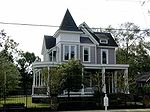 |
959-1002 Dauphin St. and 7-19 Common St. 30°41′14"N 88°3′27"W |
This historic district, centered on Common Street, has now been absorbed by the Old Dauphin Way Historic District Old Dauphin Way Historic District The Old Dauphin Way Historic District is a historic district in the city of Mobile, Alabama, United States. It was named for Dauphin Way, now known as Dauphin Street, which bisects the center of the district from east to west. The district is roughly bounded by Broad Street on the east,... . It remains individually listed on the National Register and contains examples of Greek Revival, Italianate, and Queen Anne style architecture. |
|
| 21 | Convent and Academy of the Visitation Convent and Academy of the Visitation The Convent and Academy of the Visitation, properly known today as the Visitation Monastery, is a historic complex of Roman Catholic religious buildings and a small cemetery in Mobile, Alabama, United States. The buildings and grounds were documented by the Historic American Buildings Survey in 1937... |
2300 Springhill Ave. 30°41′38"N 88°5′38"W |
This historic district encompasses the convent Convent A convent is either a community of priests, religious brothers, religious sisters, or nuns, or the building used by the community, particularly in the Roman Catholic Church and in the Anglican Communion... for the Order of the Visitation of Holy Mary Order of the Visitation of Holy Mary The Order of the Visitation of Holy Mary or the Visitation Order is a Roman Catholic religious order for women. Members of the order are also known as Filles de Sainte-Marie, Visitandines, Salesian Sisters and, more commonly, Visitationists.- History of the order :The Order was founded in 1610 by... , now known as the Visitation Monastery. The earliest structures date from 1855 with the latest dating to the 1890s. Architectural styles include the Renaissance Revival Neo-Renaissance Renaissance Revival is an all-encompassing designation that covers many 19th century architectural revival styles which were neither Grecian nor Gothic but which instead drew inspiration from a wide range of classicizing Italian modes... and Romanesque Revival Romanesque Revival architecture Romanesque Revival is a style of building employed beginning in the mid 19th century inspired by the 11th and 12th century Romanesque architecture... styles. |
||
| 22 | Convent of Mercy Convent of Mercy (Mobile, Alabama) The Convent of Mercy, known today as the St. Francis Place Condominiums, is a small complex of historic Roman Catholic religious buildings in Mobile, Alabama, United States. It consists of two buildings, the former convent and the former school... |
753 St. Francis St. 30°41′20"N 88°3′10"W |
This -story Baroque Revival style building was completed in 1908. It once served as the convent for the Sisters of Mercy Sisters of Mercy The Religious Order of the Sisters of Mercy is an order of Catholic women founded by Catherine McAuley in Dublin, Ireland, in 1831. , the order has about 10,000 members worldwide, organized into a number of independent congregations.... , but has now been converted into condominiums. |
||
| 23 | D'Iberville Apartments D'Iberville Apartments The D'Iberville Apartments is a complex of historic apartment buildings located in Mobile, Alabama. They were built in 1943 to the designs of architects Harry Pembleton and Aurelius Augustus Evans... |
2000 Spring Hill Ave. 30°41′37"N 88°5′22"W |
This complex of apartment buildings in Midtown was built in the Minimal Traditionalist style in 1943, coinciding with Mobile's rapid growth during World War II World War II World War II, or the Second World War , was a global conflict lasting from 1939 to 1945, involving most of the world's nations—including all of the great powers—eventually forming two opposing military alliances: the Allies and the Axis... . |
||
| 24 | Dahm House Dahm House The Dahm House is a historic townhouse in Mobile, Alabama. The two-story brick structure was built in 1873 for John Dahm. It was designed by Bassett Capps. A two-story frame addition was added in 1929. The house was added to the National Register of Historic Places on January 05, 1984... |
 |
7 N. Claiborne St. 30°41′27"N 88°2′46"W |
This two-story brick townhouse was built for John Dahm in 1873. | |
| 25 | Davis Avenue Branch, Mobile Public Library National African American Archives and Museum The National African American Archives and Museum, formerly the Davis Avenue Branch of the Mobile Public Library, is an archive and history museum located in Mobile, Alabama... |
564 Dr. Martin Luther King Jr. Ave. 30°41′43"N 88°3′9"W |
The Davis Avenue Branch of the Mobile Public Library Mobile Public Library The Mobile Public Library is public library system primarily serving Mobile County, Alabama. The system is a department of the city of Mobile and receives funding from Mobile County and the city of Saraland.-History:... was built in 1931 to serve Mobile's African American community during the era of racial segregation. The building is a smaller version of the main library on Government Street. It now serves as the National African American Archives and Museum. It is on the African American Heritage Trail of Mobile. |
||
| 26 | Davis Avenue Recreation Center Davis Avenue Recreation Center The Davis Avenue Recreation Center is a historic recreation facility in Mobile, Alabama. The facility was established in 1921 as the first public leisure center for African Americans in segregated Mobile. Initially known as the Davis Avenue Community House, it also featured tennis courts, a... |
1361 Dr. Martin Luther King Jr. Ave. 30°42′0"N 88°3′58"W |
Founded in 1921 as the Davis Avenue Community House, this was the first public recreation center for African Americans in Mobile. The current building dates to 1936 and was built using Works Progress Administration funds. | ||
| 27 | De Tonti Square Historic District De Tonti Square Historic District -References:... |
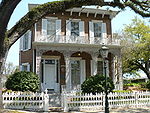 |
Roughly bounded by Adams, St. Anthony, Claiborne, and Conception Sts. 30°41′45"N 88°2′50"W |
This historic district is primarily an antebellum neighborhood with over 60 contributing buildings. Many of the houses are two-story brick townhouses built in the Late Federal style with Greek Revival influences. | |
| 28 | Denby House Denby House The Denby House is a historic raised cottage in Mobile, Alabama. The one-story brick house was built by Charles Denby in 1873. It was added to the National Register of Historic Places on January 05, 1984. In addition to being listed individually on the National Register of Historic Places, it is... |
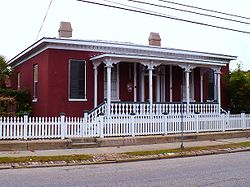 |
558 Conti St. 30°41′19"N 88°2′57"W |
This one-story brick raised cottage was built by Charles Denby in 1873. | |
| 29 | Emanuel AME Church Emanuel AME Church (Mobile, Alabama) Emanuel African Methodist Episcopal Church is a historic African American church in Mobile, Alabama. Emanuel AME began when church trustees purchased a vacant lot for their church in 1869, as African Americans in Mobile established their own congregations following the American Civil War. The... |
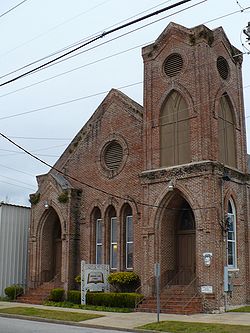 |
656 Saint Michael St. 30°41′26"N 88°3′5"W |
This historically African American church was established in 1869. James F. Hutchisson, a prominent local architect, remodeled the existing building in a Gothic Revival style in 1881. It is on the African American Heritage Trail of Mobile. | |
| 30 | Emanuel Building Emanuel Building The Emanuel Building, also known as the Bank of Mobile and Staples-Pake Building is a historic commercial building in Mobile, Alabama, United States. The three-story masonry structure was built in 1850 and then remodeled several times over the next century. It was placed on the National Register... |
100 N. Royal St. 30°41′38"N 88°2′28"W |
This three-story commercial building was built in 1850. | ||
| 31 | George Fearn House George Fearn House The George Fearn House is a historic residence in Mobile, Alabama, United States. It was built in 1904 in the Spanish Colonial Revival style by local architect George Bigelow Rogers. It was the first Spanish Colonial Revival building to be built in Mobile. The house was placed on the National... |
 |
1806 Airport Blvd. 30°40′42"N 88°4′57"W |
This house in Midtown, built in 1904, is the earliest example of the Spanish Colonial Revival style in Mobile. It was designed by George Bigelow Rogers George Bigelow Rogers George Bigelow Rogers was an American architect, best known for the wide variety of buildings that he designed in Mobile, Alabama. Born in Illinois in 1870, he studied painting in France, then apprenticed from 1894 to 1898 as an architect in Hartford, Connecticut. He stopped in Mobile in 1901,... . |
|
| 32 | Fire Station No. 5 Washington Firehouse No. 5 Washington Firehouse No. 5 is a historic fire station in Mobile, Alabama, United States. The two-story brick Greek Revival building was built in 1851 at a cost of $5,500. It was constructed to house the privately run Washington Fire Company... |
7 N. Lawrence St. 30°41′25"N 88°2′54"W |
This unusual Greek Revival style building is the earliest surviving fire station Fire station A fire station is a structure or other area set aside for storage of firefighting apparatus , personal protective equipment, fire hose, fire extinguishers, and other fire extinguishing equipment... in the city, built in 1851. |
||
| 33 | First National Bank First National Bank (Mobile, Alabama) The First National Bank is a historic bank building in Mobile, Alabama. It was built in 1905 to the designs of local architectural firm Watkins, Hutchisson, and Garvin. The two-story masonry structure is in the Classical Revival style and features a brick and terracotta facade. It was placed on... |
68 St. Francis St. 30°41′36"N 88°2′26"W |
This two-story bank building was built in the Classical Revival style in 1905. The architectural features are rendered in glazed terracotta. | ||
| 34 | Fort Conde-Charlotte Fort Conde Fort Conde, located in Mobile, Alabama, is a reconstruction, at 4/5 scale, as a third of the original 1720s French Fort Condé at the site... |
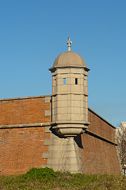 |
Church and Royal Sts. 30°41′18"N 88°2′25"W |
This reconstruction of Mobile's colonial Fort Condé was completed in 1976. The original fort foundations were discovered during the construction of the George Wallace Tunnel George Wallace Tunnel The George Wallace Tunnel is a tunnel along Interstate 10 in Mobile, Alabama that crosses beneath the Mobile River.It, like the smaller Bankhead Tunnel a few blocks upriver from it, was constructed in Mobile at the shipyards of the Alabama Drydock and Shipbuilding Company from 1969-1973... in the downtown commercial district. The current fort was rebuilt on the site after the tunnel was completed. |
|
| 35 | Gates-Daves House Gates-Daves House The Gates-Daves House, also known as The Daves Place, is a historic residence in Mobile, Alabama, United States. The one-story structure was built in 1841 with a Creole architectural influence, the best remaining example of its type in Mobile... |
1570-1572 Dauphin St. 30°41′13"N 88°4′30"W |
This house, built in 1841, is the best example of a Creole plantation house remaining in Mobile. | ||
| 36 | Georgia Cottage Georgia Cottage Georgia Cottage, also known as the Augusta Evans Wilson House, is a historic residence in Mobile, Alabama, United States. It was added to the National Register of Historic Places on September 14, 1972, based on its association with Augusta Jane Evans... |
2564 Springhill Ave. 30°41′47"N 88°6′1"W |
This Gulf Coast cottage with Greek Revival influences was the early home of authoress Augusta Jane Evans Augusta Jane Evans Augusta Jane Wilson, or Augusta Evans Wilson, was an American Southern author and one of the pillars of Southern literature. She wrote nine novels: Inez , Beulah , Macaria , St. Elmo , Vashti , Infelice , At the Mercy of Tiberius , A Speckled Bird , and Devota... . It was completed in 1840. |
||
| 37 | Government Street Presbyterian Church Government Street Presbyterian Church Government Street Presbyterian Church is one of the oldest and least-altered Greek Revival church buildings in the United States. The architectural design is by James Gallier, James Dakin, and Charles Dakin. The trio also designed Barton Academy, four blocks down Government Street to the west... |
 |
300 Government St. 30°41′22"N 88°2′37"W |
This church, designed by James Gallier, James Dakin, and Charles Dakin, was completed in 1836. Designated a National Historic Landmark National Historic Landmark A National Historic Landmark is a building, site, structure, object, or district, that is officially recognized by the United States government for its historical significance... , it is one of the oldest and least-altered Greek Revival church buildings remaining in the United States. |
|
| 38 | Greene-Marston House Greene-Marston House The Greene-Marston House, commonly known as Termite Hall, is a historic house in Mobile, Alabama, United States. It was added to the National Register of Historic Places on January 11, 1983, due to its architectural significance.-History:... |
2000 Dauphin St. 30°41′12"N 88°5′19"W |
This house, commonly known as Termite Hall, began as -story cottage in 1851. It is closely associated with Mobile's literary history. | ||
| 39 | Gulf, Mobile, and Ohio Passenger Terminal Gulf, Mobile, and Ohio Passenger Terminal The Gulf, Mobile, and Ohio Passenger Terminal is a historic train station in Mobile, Alabama, United States. Architect P. Thorton Mayre designed the Mission Revival style terminal for the Mobile and Ohio Railroad. It was completed in 1907 at a total cost of $575,000... |
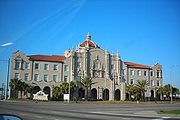 |
Beauregard and St. Joseph Sts. 30°42′1"N 88°2′44"W |
This Mission Revival style train station Train station A train station, also called a railroad station or railway station and often shortened to just station,"Station" is commonly understood to mean "train station" unless otherwise qualified. This is evident from dictionary entries e.g... was completed in 1907. It served as Mobile's terminal on the Mobile and Ohio Railroad Mobile and Ohio Railroad The Mobile and Ohio Railroad was a railroad in the Southern U.S. The M&O was chartered in January and February 1848 by the states of Alabama, Kentucky, Mississippi, and Tennessee. It was planned to span the distance between the seaport of Mobile, Alabama and the Ohio River near Cairo, Illinois... , later to become the Gulf, Mobile and Ohio Railroad Gulf, Mobile and Ohio Railroad The Gulf, Mobile and Ohio was a Class I railroad in the central United States whose primary routes extended from Mobile, Alabama, and New Orleans, Louisiana, to St... . |
|
| 40 | Hawthorn House Hawthorn House (Mobile, Alabama) The Hawthorn House is a historic house in Mobile, Alabama, United States. The -story wood-frame structure, on a brick foundation, was built in 1853 in the Gulf Coast Cottage style by Joshua K. Hawthorn. It was placed on the National Register of Historic Places on May 21, 1984, based on its... |
352 Stanton Rd. 30°41′58"N 88°5′18"W |
This Gulf Coast cottage was built by Joshua K. Hawthorn in 1853. | ||
| 41 | Martin Horst House Martin Horst House The Martin Horst House is a historic residence in Mobile, Alabama, United States. It was built in 1867 in the Italianate Style. The building was placed on the National Register of Historic Places on June 21, 1971.... |
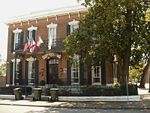 |
407 Conti St. 30°41′21"N 88°2′48"W |
This brick Italianate style house, one of the best examples remaining in the city, was completed in 1867. | |
| 42 | Hunter House | 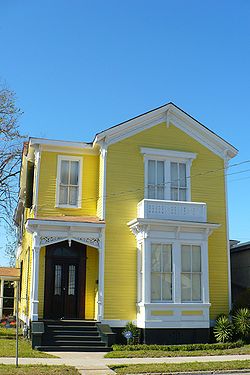 |
504 St. Francis St. 30°41′26"N 88°2′56"W |
This wood-frame Italianate style house was built by Bettie Hunter, a successful African American businesswoman and former slave, in 1878. She died less than a year after completing it. It is on the African American Heritage Trail of Mobile. | |
| 43 | International Longshoreman's Association Hall International Longshoreman's Association Hall (Mobile, Alabama) The International Longshoreman's Association Hall is a historic labor union meeting hall in Mobile, Alabama. The International Longshoremen's Association established the Mobile chapter in 1936 in order to represent the city's African American longshoremen. The hall was built in 1949 in the Art... |
505 Dr. Martin Luther King, Jr. Ave. 30°41′39"N 88°2′58"W |
The International Longshoreman’s Association (ILA) Hall dates to 1949. The Mobile chapter of the ILA was established in 1936 to represent African Americans working on the city's docks. Dr. Martin Luther King, Jr. spoke here on January 1, 1959. | ||
| 44 | Joseph Jossen House Joseph Jossen House The Joseph Jossen House, also known as the World Trade Building, is a historic house in Mobile, Alabama, United States. The -story, brick, Queen Anne–style structure was built in 1906 for Joseph Jossen. Jossen was the local agent for the F.W. Cook Brewing Company, a beer brewing company based out... |
109 N. Conception St. 30°41′35"N 88°2′39"W |
This brick Queen Anne style house was completed in 1906. It has been converted to commercial use. | ||
| 45 | Kirkbride House Conde-Charlotte House The Conde-Charlotte House, also known as the Kirkbride House, is a historic house museum in Mobile, Alabama, United States. The earliest section of the building, the rear kitchen wing, was built in 1822. The main section of the house was added a few decades later and is two and a half floors... |
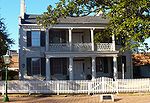 |
104 Theater St. 30°41′17"N 88°2′23"W |
The earliest section of this house, situated between the southern bastions of Fort Conde Fort Conde Fort Conde, located in Mobile, Alabama, is a reconstruction, at 4/5 scale, as a third of the original 1720s French Fort Condé at the site... , dates to 1822 and incorporates portions of a former courthouse and jail that were converted into a kitchen wing. |
|
| 46 | Leinkauf Historic District Leinkauf Historic District The Leinkauf Historic District is a historic district in the city of Mobile, Alabama, United States. It was placed on the National Register of Historic Places on 24 June 1987. It is roughly bounded by Government, Eslava, Lamar, and Monterey Streets. The district covers and contains 303... |
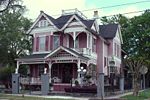 |
Roughly bounded by Government, S. Monterey, Eslava, Lamar, and S. Monterey Sts. 30°40′38"N 88°4′22"W |
This historic district is a late 19th and early 20th century neighborhood consisting of over 300 buildings. Architectural styles range from Queen Anne to Craftsman. | |
| 47 | George Levy House George Levy House The George Levy House is a historic residence in Mobile, Alabama, United States. It was built in 1927 in the Spanish Colonial Revival style. The building was placed on the National Register of Historic Places on July 12, 1991. It is a part of the Spanish Revival Residences in Mobile Multiple... |
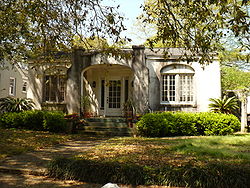 |
107 Florence Pl. 30°41′21"N 88°5′22"W |
This Spanish Colonial Revival style house in the Florence Place subdivision was completed in 1927. | |
| 48 | Martin Lindsey House Martin Lindsey House The Martin Lindsey House, also known as the Roy and Barbara Hoppmyer House, is a historic house in Mobile, Alabama, United States. The one-story wood-frame structure was built in 1915 for Martin Lindsey on Mobile Bay, along what was, at that time, the Bay Shell Road... |
3112 Bay Front Rd. 30°36′24"N 88°3′34"W |
This house, built in 1915, features a local vernacular Vernacular architecture Vernacular architecture is a term used to categorize methods of construction which use locally available resources and traditions to address local needs and circumstances. Vernacular architecture tends to evolve over time to reflect the environmental, cultural and historical context in which it... style. It sits on Mobile Bay, along a remnant of the old Bay Shell Road. |
||
| 49 | Lower Dauphin Street Historic District Lower Dauphin Street Historic District The Lower Dauphin Street Historic District is a historic district in the city of Mobile, Alabama, United States. It was placed on the National Register of Historic Places on 9 February 1979. The district encompasses all of Dauphin Street from Water Street to Jefferson Street. It covers and... |
171-614 Dauphin St.; also Dauphin St. from Water to Dearborn Ave.; also roughly Dauphin St. from Jefferson St. to Dearborn St., and the southern side of St. Francis St. from Bayou St. to Lawrence St.; also 310 St. Francis St. 30°41′24"N 88°2′47"W |
This historic district encompasses much of Mobile's oldest intact business district. Second, third, and fourth sets of boundaries represent boundary increases of , , and respectively | ||
| 50 | Magnolia Cemetery including Mobile National Cemetery Magnolia Cemetery (Mobile, Alabama) Magnolia Cemetery is a city cemetery located in Mobile, Alabama, United States. The cemetery is situated on and was established in 1836. From that time onward it served as Mobile's primary burial site during the 19th century. It is the final resting place for many of Mobile's 19th and early 20th... |
Ann and Virginia Sts. 30°40′28"N 88°3′45"W |
This city cemetery was established in 1836 and served as Mobile's primary burial site during the remainder of the 19th century. It contains more than 80,000 burials and features many elaborate monuments. | ||
| 51 | Meaher-Zoghby House Meaher-Zoghby House The Meaher-Zoghby House is a historic townhouse in Mobile, Alabama. The two-story brick structure was built in 1901 for Augustine Meaher. It retains its original cast iron details and front yard fence. The house was added to the National Register of Historic Places on January 05, 1984... |
5 N. Claiborne St. 30°41′27"N 88°2′46"W |
This two-story brick townhouse was built in 1901 for Augustine Meaher. | ||
| 52 | Ernest Megginson House Ernest Megginson House The Ernest Megginson House is a historic residence in Mobile, Alabama, United States. It was built in 1927 in the Spanish Colonial Revival style. The building was placed on the National Register of Historic Places on July 12, 1991. It is a part of the Spanish Revival Residences in Mobile Multiple... |
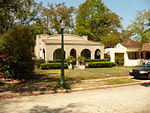 |
143 Florence Pl. 30°41′25"N 88°5′22"W |
This Spanish Colonial Revival style house in the Florence Place subdivision was completed in 1927. | |
| 53 | Metzger House Metzger House The Metzger House is a historic residence in Mobile, Alabama, United States. The one-story Italianate-influenced brick structure was built by the Metzger family in 1875. It was added to the National Register of Historic Places on January 5, 1984, due to its architectural significance.... |
7 N. Hamilton St. 30°41′25"N 88°2′51"W |
This one-story Italianate house was completed in 1875. | ||
| 54 | Midtown Historic District Midtown Historic District (Mobile, Alabama) The Midtown Historic District is a historic district in the city of Mobile, Alabama, United States. It was placed on the National Register of Historic Places on 29 November 2001. It is roughly bounded by Taylor Avenue, Government Street, Houston Street, Kenneth Street, Springhill Avenue, and... |
 |
Roughly bounded by Taylor Ave., U.S. Route 90 U.S. Route 90 U.S. Route 90 is an east–west United States highway. Despite the "0" in its route number, U.S. 90 never was a full coast-to-coast route; it has always ended at Van Horn, Texas. A short-lived northward extension to U.S... , Houston St., Kenneth St., U.S. Route 98 U.S. Route 98 U.S. Route 98 is an east–west United States highway that runs from western Mississippi to southern Florida. It was established in 1933 as a route between Pensacola, Florida and Apalachicola, Florida, and has since been extended westward into Mississippi and eastward across the Florida... , and Florida St. 30°41′0"N 88°4′44"W |
This historic district is made up of 20th century neighborhoods and contains 1270 contributing buildings. | |
| 55 | Miller-O'Donnell House Miller-O'Donnell House The Miller-O'Donnell House was a historic residence in Mobile, Alabama, United States. The two-story house was built in 1837 in the Gulf Coast Cottage style. It featured a masonry brick ground floor with a wood-frame main floor above. It was placed on the National Register of Historic Places on... |
1102 Broad St. 30°39′52"N 88°3′25"W |
This was the site of a raised Gulf Coast cottage, built in 1837. It has been destroyed. | ||
| 56 | Mobile City Hall Old City Hall (Mobile, Alabama) Old City Hall, also known as the Southern Market, is a historic complex of adjoining buildings in Mobile, Alabama, that currently houses the Museum of Mobile. The complex was built from 1855 to 1857 to serve as a city hall and as a marketplace... |
 |
111 S. Royal St. 30°41′22"N 88°2′22"W |
This National Historic Landmark was built to serve the combined functions of a market and city administration. It was completed in an Italianate style in 1857. | |
| 57 | Mobile City Hospital Mobile City Hospital Mobile City Hospital, also known as Old Mobile General Hospital, is a historic Greek Revival hospital building in Mobile, Alabama, United States. It was built in 1830 by Thomas S. James and served as a hospital for the city of Mobile from 1831 until 1966. It was administered for the city by the... |
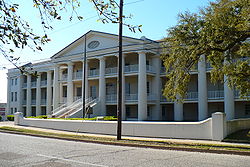 |
900-950 St. Anthony St. 30°41′32"N 88°3′22"W |
This three-story brick hospital was completed in 1830. The Greek Revival style building served as the city-run hospital from 1831 until 1966. It served as a Confederate hospital during the American Civil War American Civil War The American Civil War was a civil war fought in the United States of America. In response to the election of Abraham Lincoln as President of the United States, 11 southern slave states declared their secession from the United States and formed the Confederate States of America ; the other 25... . |
|
| 58 | Monterey Place Monterey Place Monterey Place, best known as the Shepard House, is a historic residence in Mobile, Alabama, United States. The house was designed by architect George Franklin Barber in 1897 for Charles Martin Shepard, the general passenger agent for the Mobile and Ohio Railroad in Mobile... |
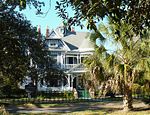 |
1552 Monterey Pl. 30°41′3"N 88°4′27"W |
Best known as the Shepard House, this Queen Anne style residence was completed in 1897. | |
| 59 | James Arthur Morrison House James Arthur Morrison House The James Arthur Morrison House, also known as the Morrison-Walker House, is a historic Spanish Colonial Revival style house and garage/guest house in Mobile, Alabama, United States. The two-story stucco and concrete main house was completed in 1926... |
159 Hillwood Rd. 30°41′38"N 88°8′59"W |
This Spanish Colonial Revival style house in the Spring Hill neighborhood was completed in 1926. | ||
| 60 | Mt. Olive Missionary Baptist Church No.1 Mount Olive Missionary Baptist Church (Mobile, Alabama) Mt. Olive Missionary Baptist Church No.1 is a historic Missionary Baptist church building in Mobile, Alabama. The church was built in 1916 by the local African American community. It was added to the National Register of Historic Places on May 29, 2008, based on its architectural... |
409 Lexington Ave. 30°41′59"N 88°4′8"W |
This historically African American Baptist church was built in a vernacular style in 1916. | ||
| 61 | Murphy High School |  |
100 S. Carlen St. 30°40′55"N 88°5′10"W |
This Spanish Colonial Revival style school opened as Mobile High School in 1926. | |
| 62 | Neville House Neville House (Mobile, Alabama) The Neville House is a historic brick townhouse in Mobile, Alabama, United States. It was built in 1896, in an Italianate-influenced style. The building was placed on the National Register of Historic Places on January 05, 1984.... |
 |
255 St. Francis St. 30°41′30"N 88°2′42"W |
This two-story brick townhouse was completed in 1896. | |
| 63 | Oakleigh Oakleigh Historic Complex (Mobile, Alabama) Oakleigh is a historic house museum in Mobile, Alabama, United States. It is the centerpiece of the Oakleigh Historic Complex, a grouping of buildings that contain a working-class raised cottage, a former slave quarters, and a modern archives building. The name for the estate comes from a... |
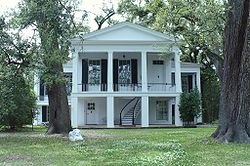 |
350 Oakleigh St. 30°40′51"N 88°3′37"W |
This raised Greek Revival mansion was completed in 1833 by James W. Roper, owner of a local brickyard Brickyard A brickyard is a place or yard where the earthen building material called bricks are made, fired, and stored, or sometimes sold or otherwise distributed from.-See also:... . The property originally included 35 acres (141,640.1 m²) of grounds, but the majority of it was converted to city lots in the mid-to-late 19th century. |
|
| 64 | Oakleigh Garden Historic District Oakleigh Garden Historic District The Oakleigh Garden Historic District is a historic district in Mobile, Alabama, United States. It was placed on the National Register of Historic Places on 13 April 1972. It is centered on Washington Square and was originally bounded by Government, Marine, Texas, and Ann Streets... |
Roughly bounded by Government, Marine, Texas, and Ann Sts.; also roughly bounded by Selma St., Broad St., Texas St., and Rapier Ave. 30°40′55"N 88°3′43"W |
Centered on the Oakleigh Mansion, this historic district contains over 280 contributing buildings. Architectural styles range from Greek Revival and Italianate to Queen Anne. Second set of boundaries represent a boundary increase of | ||
| 65 | Old Dauphin Way Historic District Old Dauphin Way Historic District The Old Dauphin Way Historic District is a historic district in the city of Mobile, Alabama, United States. It was named for Dauphin Way, now known as Dauphin Street, which bisects the center of the district from east to west. The district is roughly bounded by Broad Street on the east,... |
 |
Roughly bounded by Springhill Ave. and Broad, Government, and Houston Sts. 30°41′22"N 88°4′4"W |
The largest of Mobile's historic districts contains neighborhoods ranging from the mid-19th to early 20th centuries. It contains over 1466 contributing buildings in styles ranging from Greek Revival and Gothic Revival to Queen Anne and Craftsman. | |
| 66 | Paterson House Paterson House (Mobile, Alabama) The Paterson House is a historic residence in Mobile, Alabama, United States. The Mediterranean Revival style house was completed in 1927. It was designed by local architect Platt Roberts, who later designed Mobile's 16-story Waterman Building. It was added to the National Register of Historic... |
1673 Government St. 30°40′40"N 88°4′45"W |
This Mediterranean Revival style mansion in Midtown was completed in 1927. | ||
| 67 | J. E. Paterson House J. E. Paterson House The J. E. Paterson House is a historic residence in Mobile, Alabama, United States. It was built in 1929 in the Spanish Colonial Revival style. The building was placed on the National Register of Historic Places on July 12, 1991. It is a part of the Spanish Revival Residences in Mobile Multiple... |
118 Florence Pl. 30°41′22"N 88°5′20"W |
This Spanish Colonial Revival style house in the Florence Place subdivision was completed in 1929. | ||
| 68 | Dave Patton House Dave Patton House The Dave Patton House is a historic house in Mobile, Alabama, United States. The two-story structure was built for Dave Patton, a local African American entrepreneur... |
1252 Martin Luther King, Jr. Ave. 30°41′59"N 88°3′47"W |
This mansion was built by Dave Patton, a successful African American businessman, in 1915. It is on the African American Heritage Trail of Mobile. | ||
| 69 | Pfau-Crichton Cottage Pfau-Crichton Cottage The Pfau-Crichton Cottage, best known as Chinaberry, is a historic cottage in Mobile, Alabama, United States. The -story, wood-frame, Gulf Coast cottage was completed in 1862. The house was built by the Pfau family, but its best known resident was Miss Anne Randolph Crichton, known for the... |
3703 Old Shell Rd. 30°41′53"N 88°7′40"W |
This Gulf Coast cottage, best known as Chinaberry, was completed in 1862. Situated at the base of Spring Hill, it was once the home of Anne Randolph Crichton. She was the last direct descendant of Hugh Randolph Crichton, founder of the Mobile County town of Crichton. | ||
| 70 | Phillipi House Phillipi House The Phillipi House, also known as the Mastin House, is a historic residence in Mobile, Alabama, United States. The two-story brick masonry structure was completed in 1850. It is built in a traditional Mobile townhouse style with a Greek Revival door surround and a second floor cast iron balcony... |
53 N. Jackson St. 30°41′31"N 88°2′44"W |
This two-story brick townhouse was built in 1850. The architecture features a simple Federal style with a Greek Revival door surround. A cast iron gallery was added after the initial construction. | ||
| 71 | Pincus Building Pincus Building The Pincus Building, also known as the Zadek Building, is a historic Queen Anne-style commercial building in Mobile, Alabama, United States. The four-story brick masonry structure was designed by Rudolph Benz and completed in 1891. It first housed the Zadek Jewelry Company... |
1 S. Royal St. 30°41′31"N 88°2′27"W |
This four-story brick commercial building was completed in 1891 in the Queen Anne style. | ||
| 72 | Bishop Portier House Bishop Portier House The Bishop Portier House is a historic residence in Mobile, Alabama, United States. It sits diagonally across from the Cathedral of the Immaculate Conception, and faces Cathedral Square. It is owned by the Roman Catholic Archdiocese of Mobile. The house, built circa 1834, is one of Mobile's best... |
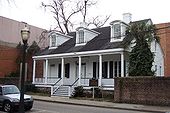 |
307 Conti St. 30°41′23"N 88°2′42"W |
This Creole cottage was completed in 1833. It served as the residence of Michael Portier Michael Portier Bishop Michael Portier was a Roman Catholic bishop and the firstBishop of Mobile. He immigrated to the United States in 1817.... , Mobile's first Roman Catholic bishop. |
|
| 73 | Protestant Children's Home Protestant Children's Home The Protestant Children's Home, also known as the Protestant Orphans' Asylum, is a historic building in Mobile, Alabama, United States. It was placed on the National Register of Historic Places on June 18, 1973.-History:... |
911 Dauphin St. 30°41′14"N 88°3′20"W |
This Late Federal style building was completed in 1845. It served as a Protestant orphanage Orphanage An orphanage is a residential institution devoted to the care of orphans – children whose parents are deceased or otherwise unable or unwilling to care for them... . |
||
| 74 | Roberts House Roberts House (Mobile, Alabama) The Roberts House is a historic Tudor Revival style residence and two dependencies in Mobile, Alabama, United States. Built in the 1920s upper-class suburb of County Club Estates, the complex was designed by J. F. Pate. The rambling two-story red brick mansion was completed in 1929... |
3 Wimbledon Dr. 30°41′10"N 88°9′1"W |
This Tudor Revival mansion was completed in 1929. | ||
| 75 | Ross Knox House Ross Knox House The Ross Knox House is a historic Tudor Revival style residence in Mobile, Alabama, United States. The two-story brick and stucco house was completed in 1929. It is considered one of the best Tudor Revival houses in Mobile by the Alabama Historical Commission... |
102 Hillwood Rd. 30°41′16"N 88°8′58"W |
This Tudor Revival house was completed in 1929. | ||
| 76 | St. Francis Street Methodist Church St. Francis Street Methodist Church St. Francis Street Methodist Church, officially St. Francis Street United Methodist Church, is a historic United Methodist Church building in Mobile, Alabama, United States. The current structure was built in 1896 by the architectural firm of Watkins and Johnson. It was placed on the National... |
15 N. Joachim St. 30°41′30"N 88°2′40"W |
This Methodist United Methodist Church The United Methodist Church is a Methodist Christian denomination which is both mainline Protestant and evangelical. Founded in 1968 by the union of The Methodist Church and the Evangelical United Brethren Church, the UMC traces its roots back to the revival movement of John and Charles Wesley... church building was completed in 1896. |
||
| 77 | Saint Francis Xavier Roman Catholic Church Saint Francis Xavier Roman Catholic Church (Mobile, Alabama) Saint Francis Xavier Roman Catholic Church, also known as St. Francis Xavier Church, is a historic Roman Catholic church building in the Toulminville neighborhood of Mobile, Alabama, United States. It serves as the parish church for St. Francis Xavier Parish in the Roman Catholic Archdiocese of... |
2034 St. Stephens Rd. 30°42′33"N 88°4′49"W |
This Roman Catholic church building in the Toulminville neighborhood was built in 1916, after the previous building was destroyed in a hurricane. | ||
| 78 | Saint Joseph's Roman Catholic Church |  |
808 Springhill Ave. 30°41′23"N 88°3′14"W |
This Gothic Revival church building was completed in 1909. It serves as the parish Parish (Catholic Church) In the Roman Catholic Church, a parish is the lowest ecclesiastical geographical subdivision: from ecclesiastical province to diocese to deanery to parish.-Requirements:A parish needs two things under common law to become a parish... church for St. Joseph's Parish, established in 1857. |
|
| 79 | St. Louis Street Missionary Baptist Church St. Louis Street Missionary Baptist Church St. Louis Street Missionary Baptist Church is a historic African American church in Mobile, Alabama. It was added to the National Register of Historic Places on October 08, 1976, due to its architectural and historic significance.-History:St... |
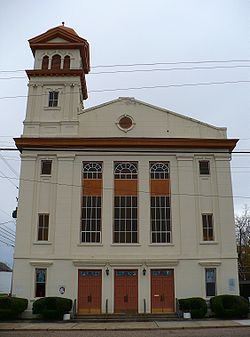 |
108 N. Dearborn St. 30°41′27"N 88°3′3"W |
This Missionary Baptist church began with a rift in Mobile's African Baptist Church, later to become the Stone Street Baptist Church Stone Street Baptist Church Stone Street Baptist Church is a historic African American Baptist church in Mobile, Alabama. The congregation was established well before the American Civil War, with Stone Street Baptist recognized today as one of Alabama's most influential... . The new congregation that split from the original formed this church. They purchased this property in 1859 and constructed a church. This Classical Revival building was built in 1872. In 1874 they hosted the seventh Colored Baptist Convention of Alabama here, which led to the formation of Selma University Selma University Selma University is a private, historically black, bible college located in Selma, Alabama, United States. It is affiliated with the Alabama State Missionary Baptist Convention.-History:... . It is on the African American Heritage Trail of Mobile. |
|
| 80 | Saint Matthew's Catholic Church | 1200 S. Marine St. 30°39′46"N 88°3′28"W |
This Roman Catholic parish church was built in the Mediterranean Revival style in 1913, shortly after the formation of its parish. | ||
| 81 | Saint Paul's Episcopal Chapel Saint Paul's Episcopal Chapel Saint Paul's Episcopal Chapel is a historic Episcopal church building in Mobile, Alabama, United States. It was built in 1859 in a vernacular Gothic Revival style. The building was placed on the National Register of Historic Places as a part of the 19th Century Spring Hill Neighborhood Thematic... |
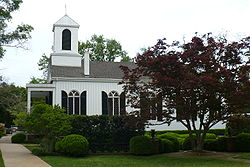 |
4051 Old Shell Rd. 30°41′53"N 88°8′20"W |
This wood-frame Episcopal chapel in the Spring Hill neighborhood was completed in 1859. It is an example of Carpenter Gothic Carpenter Gothic Carpenter Gothic, also sometimes called Carpenter's Gothic, and Rural Gothic, is a North American architectural style-designation for an application of Gothic Revival architectural detailing and picturesque massing applied to wooden structures built by house-carpenters... architecture. |
|
| 82 | Saint Vincent de Paul Saint Vincent de Paul (Mobile, Alabama) Saint Vincent de Paul, now known as Prince of Peace Church is a historic Roman Catholic church building in Mobile, Alabama. It was designed by a local architect, James H. Hutchisson, in the Gothic Revival style. The current building was built in 1874 and dedicated on January 21, 1877... |
 |
351 S. Lawrence St. 30°40′56"N 88°2′42"W |
This Roman Catholic church, now known as Prince of Peace Church, began with an earlier frame structure, completed in 1847, that served as parish church for Saint Vincent de Paul Parish. This brick Gothic Revival building was built in 1872. Saint Vincent de Paul Parish was enlarged and renamed Prince of Peace Parish in 1970. | |
| 83 | Scottish Rites Temple Scottish Rite Temple (Mobile, Alabama) The Scottish Rite Temple, now known as The Temple Downtown, is a historic former masonic building in Mobile, Alabama, United States. It was built to serve as the meeting place for the Ancient and Accepted Scottish Rite of Freemasonry... |
351 St. Francis St. 30°41′29"N 88°2′46"W |
This Egyptian Revival building was completed in 1921 for the Scottish Rite Scottish Rite The Ancient and Accepted Scottish Rite of Freemasonry , commonly known as simply the Scottish Rite, is one of several Rites of the worldwide fraternity known as Freemasonry... of Freemasonry Freemasonry Freemasonry is a fraternal organisation that arose from obscure origins in the late 16th to early 17th century. Freemasonry now exists in various forms all over the world, with a membership estimated at around six million, including approximately 150,000 under the jurisdictions of the Grand Lodge... . It was designed by George B. Rogers. |
||
| 84 | Raphael Semmes House Raphael Semmes House The Raphael Semmes House, also known as the Horta-Semmes House, is a historic residence in Mobile, Alabama. It is best known for having been the home of Admiral Raphael Semmes, captain of the Confederate sloop-of-war CSS Alabama... |
804 Government St. 30°41′12"N 88°3′8"W |
This two-story brick townhouse was completed in 1858. It is famous as the post-war home of Admiral Raphael Semmes Raphael Semmes For other uses, see Semmes .Raphael Semmes was an officer in the United States Navy from 1826 - 1860 and the Confederate States Navy from 1860 - 1865. During the American Civil War he was captain of the famous commerce raider CSS Alabama, taking a record sixty-nine prizes... , captain of the Confederate Confederate States of America The Confederate States of America was a government set up from 1861 to 1865 by 11 Southern slave states of the United States of America that had declared their secession from the U.S... sloop-of-war Sloop-of-war In the 18th and most of the 19th centuries, a sloop-of-war was a warship with a single gun deck that carried up to eighteen guns. As the rating system covered all vessels with 20 guns and above, this meant that the term sloop-of-war actually encompassed all the unrated combat vessels including the... CSS Alabama CSS Alabama CSS Alabama was a screw sloop-of-war built for the Confederate States Navy at Birkenhead, United Kingdom, in 1862 by John Laird Sons and Company. Alabama served as a commerce raider, attacking Union merchant and naval ships over the course of her two-year career, during which she never anchored in... . |
||
| 85 | Sodality Chapel Sodality Chapel The Sodality Chapel is a historic Roman Catholic chapel building on the campus of Spring Hill College in Mobile, Alabama, United States. It was built in 1850 in a simple Greek Revival style. The building was placed on the National Register of Historic Places as a part of the 19th Century Spring... |
4307 Old Shell Rd. 30°41′30"N 88°8′13"W |
This small Roman Catholic chapel building on the campus of Spring Hill College Spring Hill College Spring Hill College is a private, Roman Catholic Jesuit liberal arts college in the United States. It was founded in 1830 on the Gulf Coast in Mobile, Alabama, by Most Rev. Michael Portier, Bishop of Mobile, Alabama... was completed in 1850. |
||
| 86 | South Lafayette Street Creole Cottages South Lafayette Street Creole Cottages The South Lafayette Street Creole Cottages is a grouping of three historic Creole cottages on South Lafayette Street in Mobile, Alabama, United States. They were built in 1852. All three were placed as a group on the National Register of Historic Places on November 07, 1976.... |
 |
20, 22, and 23 S. Lafayette St. 30°41′7"N 88°4′17"W |
These three Creole cottages on South Lafayette Street were all completed in 1852. | |
| 87 | Robert L. Spotswood House Robert L. Spotswood House The Robert L. Spotswood House, also known as the J. Clyde Glenn House, is a historic residence in Mobile, Alabama, United States. It was built in 1926 in the Spanish Colonial Revival style. The house was placed on the National Register of Historic Places on July 12, 1991, as a part of the Spanish... |
1 Country Club Rd. 30°41′33"N 88°9′1"W |
The Spanish Colonial Revival house in the Spring Hill neighborhood was completed in 1926. | ||
| 88 | Spring Hill College Quadrangle | 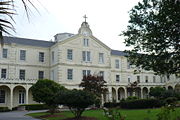 |
4307 Old Shell Rd. 30°41′35"N 88°8′13"W |
This grouping of structures on the campus of Spring Hill College includes the Renaissance Revival style Administration Building, completed in 1869, and the Gothic Revival style St. Joseph's Chapel, completed in 1910. | |
| 89 | State Street AME Zion Church State Street AME Zion Church State Street African Methodist Episcopal Zion Church is a historic African American church in Mobile, Alabama. It is the oldest documented Methodist church building in Alabama... |
 |
502 State St. 30°41′37"N 88°3′0"W |
This is Mobile's oldest African American congregation, established in 1829 as the African Church of the City of Mobile. The current Romanesque Revival building was completed in 1854; it is the oldest remaining Methodist church building in Alabama. It is on the African American Heritage Trail of Mobile. | |
| 90 | Amelia Stewart House Amelia Stewart House The Amelia Stewart House, also known as the Carol O. Wilkinson House and William Hallett House, is a historic residence in Mobile, Alabama, United States. It was built in 1835 in the Greek Revival style. The house was placed on the National Register of Historic Places on May 29, 1992, based on its... |
137 Tuscaloosa St. 30°41′25"N 88°5′18"W |
This Greek Revival cottage in Midtown was completed in 1835. | ||
| 91 | Stewartfield | 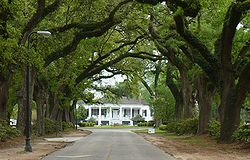 |
4307 Old Shell Rd. 30°41′38"N 88°8′32"W |
This raised Greek Revival mansion in the Spring Hill neighborhood was completed in 1849. | |
| 92 | Stone Street Baptist Church Stone Street Baptist Church Stone Street Baptist Church is a historic African American Baptist church in Mobile, Alabama. The congregation was established well before the American Civil War, with Stone Street Baptist recognized today as one of Alabama's most influential... |
311 Tunstall St. 30°41′46"N 88°3′5"W |
This African American congregation, the second oldest in Mobile, was established by 1836. They moved to their present location in 1870. The current building dates to 1909. It is on the African American Heritage Trail of Mobile. | ||
| 93 | Stone Street Cemetery | 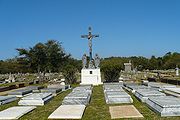 |
1700 Martin Luther King, Jr., Boulevard 30°42′32"N 88°4′25"W |
Now known as Catholic Cemetery, this cemetery was established in 1848 for the city's Roman Catholic community and religious orders by Michael Portier, the first Roman Catholic Bishop of Mobile. | |
| 94 | Trinity Episcopal Church Trinity Episcopal Church (Mobile, Alabama) Trinity Episcopal Church is a historic church in Mobile, Alabama, United States. It was the first large Gothic Revival church built in Alabama. The design was by architects Frank Wills and Henry Dudley.-History:... |
1900 Dauphin St. 30°41′11"N 88°5′9"W |
This church was designed by Frank Wills Frank Wills (architect) Frank Wills was a British-born architect who is associated with the design of early Gothic Revival churches in North America.-Biography:Frank Wills was born in Exeter, Devon England in 1822, where he started working under John Hayward, he was a member of the Exeter Architectural Society, and his... and Henry Dudley Henry Dudley Henry C. Dudley , known also as Henry Dudley, was an English-born North American architect, known for his Gothic Revival churches... . It was completed in 1857 for the city's second Episcopal congregation, established in 1845. Christ Church Cathedral Christ Church Cathedral (Mobile, Alabama) Christ Church Cathedral, also known simply as Christ Church, is a historic Episcopal cathedral located in Mobile, Alabama, USA.-History:... was the first. |
||
| 95 | Tschiener House Tschiener House The Tschiener House, also known as the Dumas School, was a historic residence in Mobile, Alabama, United States. The Carpenter Gothic structure was built in 1866. It was placed on the National Register of Historic Places on January 18, 1982. It was later destroyed by fire. One former outbuilding... |
1120 Old Shell Rd. 30°41′22"N 88°3′43"W |
This was the site of a Carpenter Gothic house, built in 1866, that has been destroyed since being listed on the National Register. | ||
| 96 | Turner-Todd Motor Company Turner-Todd Motor Company The Turner-Todd Motor Company is a historic commercial building in Mobile, Alabama, United States. The two-story brick and concrete structure was built in 1926 to house the Turner-Todd Motor Company. It was placed on the National Register of Historic Places on May 29, 2008.... |
455 St. Louis St. 30°41′31"N 88°2′56"W |
This brick commercial building was built in 1926 to house an early automobile Automobile An automobile, autocar, motor car or car is a wheeled motor vehicle used for transporting passengers, which also carries its own engine or motor... company. |
||
| 97 | U.S. Marine Hospital United States Marine Hospital (Mobile, Alabama) The United States Marine Hospital is a historic Greek Revival hospital building in Mobile, Alabama, United States. Construction began in 1838 and was completed in 1842. It was designed by architect Frederick Bunnell and was operated by the Marine Hospital Service from its opening until it closed,... |
 |
800 St. Anthony St. 30°41′28"N 88°3′16"W |
This Greek Revival hospital building was completed in 1842 for the Marine Hospital Service Marine Hospital Service The Marine-Hospital Service was an organization of Marine Hospitals dedicated to the care of ill and disabled seamen in the U.S. Merchant Marine, U.S. Coast Guard and other federal beneficiaries.... . It now serves the Mobile County Health Department. It served as a Confederate hospital during the American Civil War. |
|
| 98 | USS ALABAMA (battleship) USS Alabama (BB-60) USS Alabama , a South Dakota-class battleship, was the sixth completed ship of the United States Navy named for the U.S. state of Alabama, however she was only the third commissioned ship with that name. Alabama was commissioned in 1942 and served in World War II in the Atlantic and Pacific... |
 |
Battleship Parkway 30°40′55"N 88°0′57"W |
This World War II era South Dakota-class battleship South Dakota class battleship (1939) The South Dakota-class was a group of four fast battleships built by the United States Navy. They were the second class of battleships to be named after the 40th State; the first class was designed in the 1920s and canceled under the terms of the Washington Naval Treaty. The class comprised four... now serves as a museum ship and the centerpiece of Battleship Memorial Park Battleship Memorial Park Battleship Memorial Park is a military history park and museum located on the western shore of Mobile Bay in Mobile, Alabama. It has a collection of notable aircraft and museum ships including the South Dakota-class battleship USS Alabama and Gato-class submarine USS Drum... . She is one of two National Historic Landmarks housed within the park. |
|
| 99 | USS DRUM (submarine) USS Drum (SS-228) USS Drum is a Gato-class submarine of the United States Navy, the first Navy ship named after the drum, any of various types of fish capable of making a drumming sound. Drum is presently on display as a museum ship in Mobile, Alabama, at Battleship Memorial Park.Drum was laid down on 11 September... |
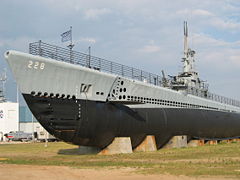 |
Battleship Parkway 30°40′50"N 88°1′0"W |
Housed at Battleship Memorial Park, this World War II era Gato-class Gato class submarine The United States Navy Gato class submarine formed the core of the submarine service that was largely responsible for the destruction of the Japanese merchant marine and a large portion of the Imperial Japanese Navy in World War II... submarine Submarine A submarine is a watercraft capable of independent operation below the surface of the water. It differs from a submersible, which has more limited underwater capability... is also a National Historic Landmark. |
|
| 100 | Arthur VanderSys House Arthur VanderSys House The Arthur VanderSys House is a historic residence in Mobile, Alabama, United States. It was built in 1926 in the Spanish Colonial Revival style. The building was placed on the National Register of Historic Places on July 12, 1991. It is a part of the Spanish Revival Residences in Mobile Multiple... |
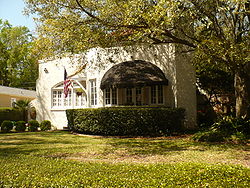 |
119 Florence Pl. 30°41′22"N 88°5′23"W |
This Spanish Colonial Revival style house in the Florence Place subdivision was completed in 1926. | |
| 101 | Jacob VanderSys House Jacob VanderSys House The Jacob VanderSys House is a historic residence in Mobile, Alabama, United States. It was built in 1927 in the Spanish Colonial Revival and Mission Revival styles. The building was placed on the National Register of Historic Places on July 12, 1991. It is a part of the Spanish Revival... |
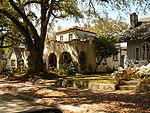 |
129 Florence Pl. 30°41′23"N 88°5′22"W |
This Spanish Colonial Revival style house in the Florence Place subdivision was completed in 1927. | |
| 102 | Vickers and Schumacher Buildings Vickers and Schumacher Buildings The Vickers and Schumacher Buildings are a pair of historic adjoining commercial buildings in downtown Mobile, Alabama. The two-story brick masonry buildings were completed in 1866 and once served to house the Schumacher Carriage Works. They were placed on the National Register of Historic Places... |
707-709 and 711 Dauphin St. 30°41′18"N 88°3′5"W |
Completed in 1866, these two commercial buildings once served the Schumacher Carriage Works. | ||
| 103 | Joseph M. Walker House Joseph M. Walker House The Joseph M. Walker House is a historic residence in Mobile, Alabama, United States. It was built in 1927 in the Spanish Colonial Revival style. The building was placed on the National Register of Historic Places on July 12, 1991. It is a part of the Spanish Revival Residences in Mobile Multiple... |
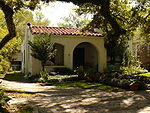 |
104 Florence Pl. 30°41′18"N 88°5′20"W |
This Spanish Colonial Revival style house in the Florence Place subdivision was completed in 1927. | |
| 104 | Weems House Weems House The Weems House, also known as Fowler Cottage, is a historic residence in Mobile, Alabama. Completed in 1870, the one-story frame structure is a late example of the Greek Revival-style. It was added to the National Register of Historic Places on October 7, 1982... |
1155 Springhill Ave. 30°41′30"N 88°3′46"W |
This late example of Greek Revival residential architecture was completed in 1870. |
See also
- List of National Historic Landmarks in Alabama
- National Register of Historic Places listings in Alabama

